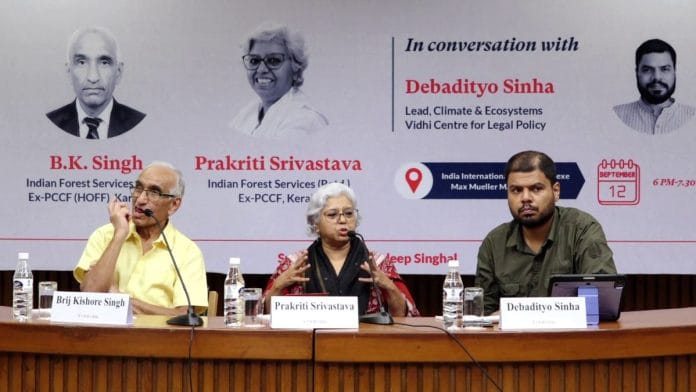New Delhi: Even though it took India nearly 25 years to start notifying ecologically sensitive zones (ESZ)—the “shock absorbers” of protected areas like national parks and wildlife sanctuaries—nothing has changed. Conservationist and former principal chief conservator of forests in Kerala, Prakriti Srivastava did not mince her words at the Vidhi Centre for Legal Policy’s The Green Mandate, Season 3.
“The existing 400-plus eco-sensitive zones only exist on paper,” said Srivastava, in conversation with her Karnataka counterpart, retired PCCF Brij Kishore Singh at New Delhi’s India International Centre on 12 September. The freewheeling conversation saw the two retired forest chiefs discuss the cost of India’s march to the drumbeat of development on its forests, its people, and natural resources.
According to Srivastava, the states’ notifications declaring eco-sensitive zones were issued only to partially follow the Supreme Court’s 2006 directive on mandatory ESZs around protected forest, national parks, and wildlife sanctuaries.
“They wanted to get over the Supreme Court’s directive, which mandated that if they failed [to comply with] ESZ notification as required by the Rule 5 of the Environment (Protection) Rules, the entire 10 kilometres around the protected areas would be considered ESZ,” said Srivastava.
In 2006, the Supreme Court directed the Ministry of Environment and Forests to provide states and Union Territories a final opportunity to respond to the ministry’s earlier communications, mandating the state governments to submit their proposals to the ministry within four weeks. It also specified that all cases where environmental clearances were granted for activities within a 10-km zone of national parks and wildlife sanctuaries be referred to the Standing Committee of the National Board of Wildlife.
Srivastava explained that the guidelines require states and Union Territories to create a zonal master plan after the ESZ notification, followed by a committee to handle the implementation and monitoring of the plan. If this condition isn’t met, the 10-km directive would come into effect.
“By announcing site-specific areas without a proper plan and monitoring committee, the authorities responsible for developing and conserving forests have become pretty comfortable. They’re basically in a winning position since they don’t have to follow the 10-kilometre rule. Meanwhile, they’re overlooking the fact that it’s ecological security and conservation efforts that are taking a hit,” she said.
Pushback from stakeholders
For all the missing conservation efforts, forest officers are blamed for not doing their jobs.
“The political existence of our leaders will be at stake if they speak about conservation — ensuring ecological security will not earn them the popularity they desire,” said Srivastava.
Aside from money and power, ‘political will’ is also heavily influenced by pressure groups like the mining and quarrying lobby. Citing the example of Karnataka’s Bannerghatta National Park, BK Singh explained how the Centre has been pressured by the states to redraw the boundaries of previously notified ESZs just to ease the concerns of mining and quarrying lobbies.
“The Supreme Court directed that there can be no mining or quarrying [around a protected area] up to 1 kilometre. Yet, in Bannerghatta National Park, mining has been going on right on the periphery of the national park,” said Singh, who was also the Head of Forest Forces (HoFF), Karnataka.
Both the retired bureaucrats were in agreement that strong lobbies control local communities residing in and around these protected areas. The broader public is manipulated into believing that conservation will negatively impact their livelihoods.
“The apprehension that it (ESZ notification) is going to impact people’s day-to-day living is a wrong premise,” said Srivastava.
According to her, most of the pushback comes from people being fed misinformation and getting roped into protests. They’re made to believe they’re the ones being impacted, but it’s false propaganda being spread by vested interest groups, including mining and construction lobbies, against conservation efforts.
“These groups misguide people, who then come out strongly against conservation, changing the entire conservation landscape. And all of this happens because these groups have a quick buck to make and their axe to grind,” Srivastava said.
Also read: 2.7 bn people exposed to risk of flooding globally, Indians most vulnerable to inland flooding
Real money is in construction, not refurbishing
The Western Ghats was a sore and painful point in the discussion.
“If all the listed Western Ghats projects were to be realised, then it will become a memory,” said BK Singh.
He gave the example of the Hubballi-Ankola Rail line which was approved by the Karnataka government in 2020. Around 800 hectares of forest land will need to be diverted, and approximately 2 lakh trees will have to be sacrificed for this development project.
Debadityo Sinha, the climate and ecosystems lead at Vidhi Centre for Legal Policy who was moderating the discussion, bemoaned the trend of pushing for large scale development projects at the cost of the environment. “The growth model India follows actually benefits from epidemics and disasters. New construction drives growth by increasing money flow, consumption, production, and contract business,” said Sinha.
(Edited by Aamaan Alam Khan)






